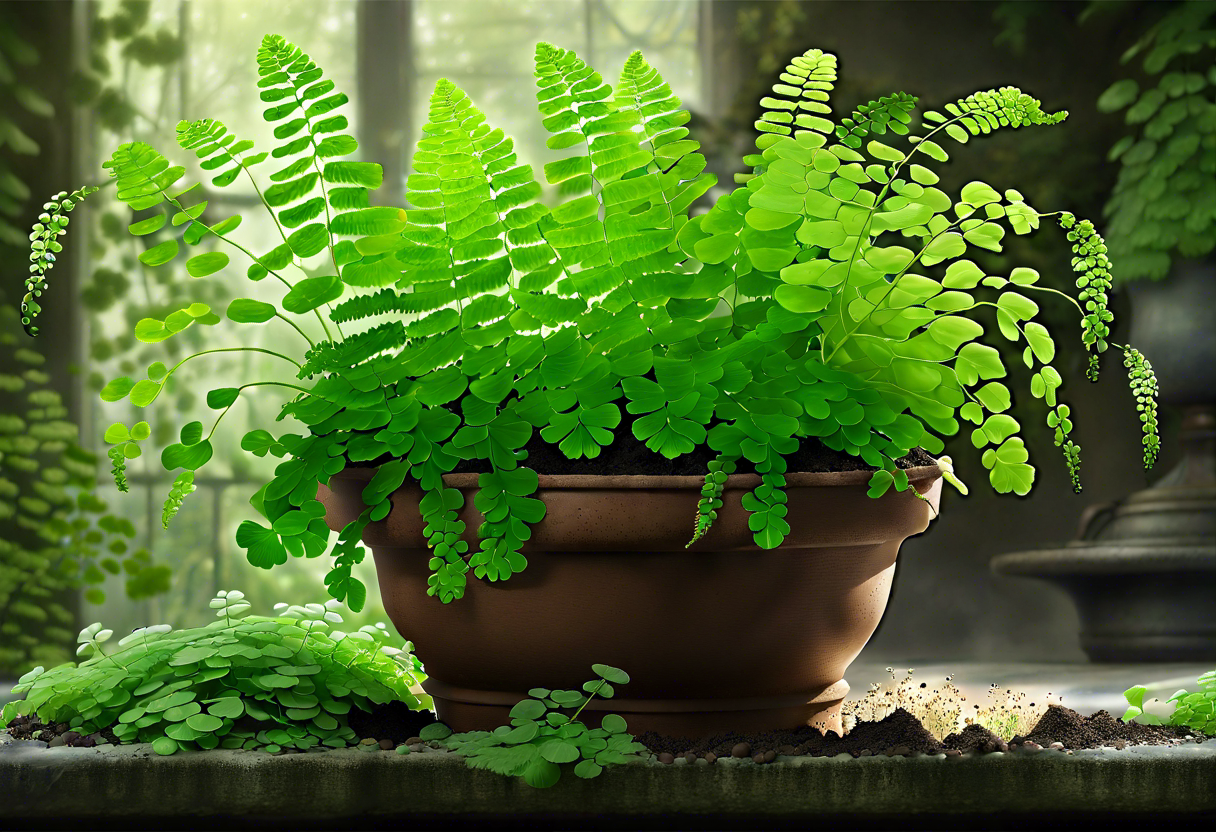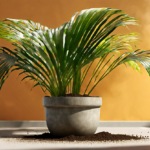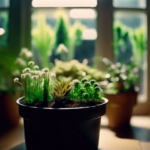Choosing the Best Soil or Potting Mix for Maidenhair Fern (Adiantum)
Maidenhair ferns, scientifically known as Adiantum, are delicate and elegant plants that require specific soil conditions to thrive. As a fern enthusiast, it is crucial to understand the specific needs of maidenhair ferns when it comes to soil or potting mix selection. Providing the right growing medium will ensure healthy growth and vibrant foliage for these charming plants.
When selecting soil or potting mix for your maidenhair ferns, it is essential to consider their natural habitat. In the wild, maidenhair ferns typically grow in well-draining soil that is rich in organic matter. Therefore, replicating these conditions is crucial for their overall health.
One of the most important factors to consider is moisture retention. Maidenhair ferns require a soil or potting mix that retains moisture without becoming waterlogged. A mix that strikes a balance between good drainage and water retention is ideal. A well-draining soil prevents root rot and fungal diseases caused by excessive moisture, while adequate moisture ensures the ferns remain hydrated.
As mentioned earlier, organic matter is vital for maidenhair ferns. Organic matter improves the soil’s fertility, enhances its structure, and promotes beneficial microbial activity. Adding compost, well-rotted manure, or leaf mold to the potting mix provides the necessary nutrients and boosts soil fertility for your ferns.
The ideal soil pH for maidenhair ferns ranges between slightly acidic and neutral. A pH level between 5.5 and 7.0 is optimal for their growth. To determine the pH of your soil or potting mix, you can use a soil testing kit available at garden centers or consult a local horticulturist.
In terms of texture, maidenhair ferns prefer a light and airy potting mix. A mixture containing ingredients such as peat moss, perlite, and sand can provide the required texture. These components ensure good drainage, prevent compaction, and allow air circulation around the roots.
When it comes to potting, it is recommended to choose a container with drainage holes to prevent waterlogging. This ensures excess water can easily drain out, maintaining the ideal moisture level in the potting mix.
The best soil or potting mix for maidenhair ferns should be well-draining, moisture-retentive, and rich in organic matter. A balanced mix with a slightly acidic to neutral pH and a light, airy texture promotes optimal growth and overall health. By providing the right soil conditions, you can enjoy the graceful beauty of maidenhair ferns thriving in your indoor or outdoor garden.
Understanding the Specific Needs of Maidenhair Ferns and Soil Conditions
Maidenhair ferns, also known as Adiantum, are elegant and delicate plants that require specific care to thrive in an indoor environment. One crucial aspect of caring for these ferns is understanding their specific needs regarding soil conditions. The right soil or potting mix can make a significant difference in their overall health and growth.
When it comes to the soil for maidenhair ferns, it is essential to consider their natural habitat. In the wild, these ferns typically grow in moist, well-draining soil with high organic matter content. The ideal soil for maidenhair ferns should mimic these conditions to ensure their well-being.
First and foremost, the soil for maidenhair ferns should be well-draining. Excess moisture can lead to root rot and other fungal diseases, which can be detrimental to the health of the plant. Therefore, it is crucial to choose a potting mix that enables water to flow freely, preventing waterlogging in the roots.
Another vital characteristic of the potting mix for maidenhair ferns is its ability to retain moisture. Although good drainage is necessary, the soil should also hold enough water to keep the roots consistently hydrated. Sandy loam or peat-based mixes are suitable options as they allow proper aeration while retaining enough moisture for the ferns.
In terms of pH, maidenhair ferns thrive in slightly acidic to neutral soil conditions. A pH range of 5.5 to 7 is optimal for the overall health of the ferns. To achieve the right pH level, you can mix organic matter such as peat moss or well-rotted compost into the potting mix.
Furthermore, the potting mix should be rich in organic matter. Adding organic materials like compost or leaf mold helps retain moisture, improve soil structure, and provide essential nutrients to the ferns. Organic matter also aids in promoting beneficial microbial activity in the soil, creating a healthy environment for the plant to grow.
When it comes to fertilization, it is crucial to be cautious with maidenhair ferns. These ferns are sensitive to excessive fertilizer, which can lead to leaf burn or even death. A light application of a balanced, water-soluble fertilizer once every few months during the growing season is sufficient to meet their nutritional needs.
The best soil or potting mix for maidenhair ferns should be well-draining, yet capable of retaining moisture. It should have a slightly acidic to neutral pH and be rich in organic matter. By providing these specific soil conditions, you can ensure the health and vitality of your maidenhair ferns, allowing them to thrive in your indoor space.
Best Soil or Potting Mix for Maidenhair Fern (Adiantum)
Common Mistakes to Avoid when Choosing Soil or Potting Mix for Maidenhair Fern
When it comes to choosing the best soil or potting mix for your Maidenhair Fern (Adiantum), there are certain common mistakes that you should avoid. These mistakes can have a significant impact on the overall health and growth of your fern. By understanding these pitfalls and making informed choices, you can create an ideal environment for your Maidenhair Fern to thrive.
One of the most common mistakes is using heavy or compacted soil for Maidenhair Ferns. These delicate ferns prefer a well-draining soil that allows water to flow freely. Heavy or compacted soil can lead to waterlogged roots and cause root rot, which can be detrimental to the health of your fern. Instead, opt for a lightweight and well-aerated soil mixture that promotes proper drainage.
Another mistake to avoid is using regular garden soil or topsoil for your Maidenhair Fern. This type of soil may not provide the necessary nutrients and pH balance that Maidenhair Ferns require. Garden soil tends to be dense and can easily become compacted, increasing the risk of root rot. Instead, choose a high-quality potting mix specifically formulated for indoor plants or ferns. These mixes are often lighter and have better water retention properties, providing optimal growing conditions for your Maidenhair Fern.
It’s important to note that while Maidenhair Ferns prefer moist soil, overwatering is a common mistake to avoid. These ferns thrive in soil that is evenly moist but not waterlogged. Overwatering can suffocate the roots and promote the growth of molds or fungi. The key is to water your Maidenhair Fern regularly but allow the soil to dry out slightly between waterings. This will prevent waterlogged conditions and ensure the health of your fern.
Avoid using soil that contains high levels of mineral salts or chemical fertilizers. Maidenhair Ferns are sensitive to these substances, and excessive salt buildup can be detrimental to their health. Instead, opt for organic fertilizers or slow-release fertilizers specifically formulated for ferns. These fertilizers provide the necessary nutrients without the risk of burning the delicate roots of your Maidenhair Fern.
When choosing soil or potting mix for your Maidenhair Fern, it’s essential to avoid common mistakes that can harm the plant. Opt for a lightweight and well-draining mix specifically formulated for indoor plants or ferns. Avoid using regular garden soil, overwatering, and soil with high mineral salt content. By providing the ideal soil conditions, you can ensure that your Maidenhair Fern thrives and remains healthy in your indoor garden.
Understanding the Specific Needs of Maidenhair Ferns and Soil conditions
The lush and delicate fronds of the Maidenhair Fern (Adiantum) make it a popular choice among plant enthusiasts. These beautiful ferns require special care to thrive, including specific soil conditions. Choosing the best soil or potting mix for your Maidenhair Fern is crucial for its overall health and growth.
Maidenhair Ferns prefer a well-draining soil that retains moisture without becoming waterlogged. The ideal soil should be rich in organic matter to provide essential nutrients and promote healthy growth. One option is to use a high-quality commercial potting mix specifically formulated for ferns. These mixes generally contain a combination of peat moss, perlite, vermiculite, and other organic additives that create a well-balanced environment for your fern.
Alternatively, you can create your own potting mix by combining equal parts of peat moss, perlite, and sand. Peat moss retains moisture while perlite and sand ensure good drainage. Adding some compost or well-rotted organic matter to the mix will further enrich the soil and provide additional nutrients for your Maidenhair Fern.
Avoid using soil that is heavy in clay or retains too much moisture, as this can lead to root rot and other fungal diseases. Similarly, using garden soil or topsoil alone is not recommended for potted Maidenhair Ferns, as they may not provide the right balance of water retention and drainage.
When repotting your Maidenhair Fern, choose a container with drainage holes to prevent water from accumulating at the bottom. This will help maintain proper moisture levels and prevent the roots from becoming waterlogged. It’s also a good practice to line the bottom of the pot with a layer of small stones or broken pottery to ensure adequate drainage.
In addition to the right soil conditions, Maidenhair Ferns also benefit from regular fertilization. You can use a balanced liquid fertilizer diluted to half strength or choose an organic slow-release fertilizer specifically designed for ferns. Apply the fertilizer during the growing season, typically from spring to early fall, following the manufacturer’s instructions.
Remember to keep an eye on your Maidenhair Fern’s moisture levels, as they prefer consistently moist soil. Water the plant when the top inch of the soil feels dry, but avoid overwatering, as this can lead to root rot. Mist the fronds regularly to mimic the fern’s natural humid environment.
By understanding the specific needs of Maidenhair Ferns and providing them with the right soil conditions, you can ensure their long-term health and enjoy their graceful beauty in your indoor or outdoor space.
The Ideal Soil or Potting Mix for Maidenhair Ferns
When it comes to the ideal soil or potting mix for Maidenhair Ferns, it is important to understand the specific needs of these delicate plants. Maidenhair Ferns, scientifically known as Adiantum, thrive in a well-draining medium that is rich in organic matter. The right soil composition can provide the necessary nutrients, moisture retention, and aeration for healthy growth.
To create the perfect soil or potting mix for your Maidenhair Fern, you will need a combination of ingredients that meet its requirements. Start with a high-quality potting mix that is specifically designed for indoor plants. This type of mix usually contains a blend of peat moss, perlite, and vermiculite. These ingredients help retain moisture while allowing excess water to drain away.
Adding organic matter to your potting mix is crucial for enhancing the nutrient content and improving drainage. well-decomposed compost or leaf mold into the mix will provide essential nutrients and promote healthy root development. Organic matter also helps to retain moisture without causing waterlogged conditions, which can be detrimental to Maidenhair Ferns.
Another important aspect is the pH level of the soil. Maidenhair Ferns prefer slightly acidic to neutral soil conditions, with a pH range of 5.5 to 7.0. To test the pH of your soil or potting mix, you can use a pH testing kit available at garden centers or online. If the pH is not within the desired range, you can adjust it by incorporating organic matter or using pH-adjusting additives.
When planting or repotting your Maidenhair Fern, make sure the pot has adequate drainage holes to prevent water retention. Excess moisture can lead to root rot and other fungal diseases that can harm the plant. Fill the pot with the prepared soil or potting mix, leaving enough space for the plant’s roots to spread comfortably. Gently place the fern in the pot and add more soil around it, ensuring that the roots are covered but not buried too deep.
It’s important to note that Maidenhair Ferns prefer humid conditions. To create a suitable environment, you can place a tray of water near the plant or use a humidifier. This will help to maintain the moisture levels in the soil and prevent the fern from drying out.
The best soil or potting mix for Maidenhair Ferns consists of a well-draining blend of high-quality potting mix, organic matter such as compost or leaf mold, and the right pH level. By providing the ideal soil conditions, you can ensure the optimal growth and health of your Maidenhair Fern.
Conclusion
Choosing the best soil or potting mix for your maidenhair fern (Adiantum) is crucial for its overall health and growth. Understanding the specific needs of maidenhair ferns and soil conditions is essential to create an ideal growing environment. Avoiding common mistakes when selecting soil or potting mix will help prevent potential problems and ensure the plant thrives. When it comes to fertilizers, both organic and synthetic options can be used, but organic fertilizers are generally considered better for maidenhair ferns due to their gentle and slow-release nature. preparing and maintaining the ideal soil or potting mix for your maidenhair fern involves providing adequate moisture, drainage, and nutrients, while ensuring the mix is well-aerated.
To provide the best growing conditions for your maidenhair fern, it is important to choose the right soil or potting mix. Maidenhair ferns prefer a well-draining mix that is rich in organic matter. A recommended mix for these delicate plants would consist of equal parts peat moss, perlite, and well-rotted leaf compost. This combination provides the necessary moisture retention, while also allowing excess water to drain away, preventing root rot. It is important to note that maidenhair ferns are sensitive to salts, so using a soil mix without added fertilizers or chemicals is ideal.
Understanding the specific needs of maidenhair ferns and soil conditions is crucial for their successful growth. These ferns thrive in a humid environment with indirect light, so placing them in a location away from direct sunlight is beneficial. Additionally, maintaining consistent moisture levels is important, as too much or too little water can be detrimental to the plant’s health. The soil should always be slightly damp but not waterlogged. Mist the fronds regularly or use a pebble tray to increase humidity levels and prevent the foliage from drying out.
When selecting soil or potting mix for your maidenhair fern, there are certain mistakes to avoid. Using heavy, compacted soil or a mix that retains too much water can lead to root rot and other diseases. Avoid adding sand to the mix, as it does not improve drainage and can make the soil compacted. Furthermore, using soil from the garden is not recommended, as it may contain pests or diseases that can harm the maidenhair fern.
Choosing between organic and synthetic fertilizers is a decision to consider for optimal maidenhair fern growth. While synthetic fertilizers may provide immediate results, they can also cause salt build-up and harm the delicate roots of the fern. Organic fertilizers, on the other hand, offer a gentler and slow-release option, enhancing the soil structure and promoting microbial activity. Compost, worm castings, or a balanced organic fertilizer can be applied once every two to three months during the growing season to provide the necessary nutrients.
To prepare and maintain the ideal soil or potting mix, ensure there is adequate moisture and drainage. Water the fern thoroughly until the excess drains from the bottom of the pot, then allow the top inch of soil to dry out before watering again. This prevents overwatering, which can lead to root rot. Maintaining the proper level of humidity is also essential. Misting the fronds or placing a tray filled with water and pebbles beneath the pot helps create a humid microclimate.
Providing the best soil or potting mix for your maidenhair fern is vital for its overall health and growth. Understanding the specific needs of the fern and avoiding common mistakes when choosing soil is important. Opting for organic fertilizers can benefit the plant, and proper preparation and maintenance will ensure the ideal growing conditions. By following these guidelines, you can cultivate a thriving and beautiful maidenhair fern in your home or garden.


